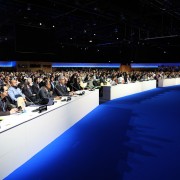Peter Gleick: Water and Misleading Advertising and Marketing–Where are the FDA and FTC?
Advertising is the art of convincing people to spend money they don’t have for something they don’t need. — Will Rogers
It may be necessary to fool people for their own good…Average intelligence is surprisingly low. It is so much more effectively guided by its subconscious impulses and instincts than by its reason. — John Benson, President of the American Association of Advertising Agencies
It should be hard to sell private water. After all, most of the people reading this blog have access, a few feet away, to unlimited, remarkably cheap, high-quality tap water from systems owned by the public. So in order to sell water and water-related products, advertisers and marketers have to pull out all the tricks in the book. In particular, they can’t sell “water”–they have to sell youth, health, beauty, romance, status, image, and, of course, the old standbys, sex and fear.
For bottled water, all of these tricks are being employed, despite federal laws that require manufacturers to use honest labels about contents and restrict advertisers from making unsubstantiated health or medical claims. As early as 1906, the United States passed the Pure Food and Drug Act that required that claims about products could not contain any “statement, design, or device” that was “false or misleading in any particular.”
But bottled water companies today are advertising all sorts of bottled waters and water-treatment devices as miracle cures for all sorts of ills. Consumers can find water “ionizers,” vibrationally charged interactive water, energy enhanced water infused with luck or love, weight-loss waters, super-oxygenated water machines, magnetized water, rhythm-structured water, and on and on. Many of these are described in detail in my new book “Bottled and Sold: The Story Behind Our Obsession with Bottled Water.” They are just some of the magical bottled waters and devices pushed on ignorant consumers or people with real health concerns who don’t know where else to turn for help. Pseudoscientific claims for bottled waters can be found in brochures, health stores, and magazines, and especially on the Internet. As use of the Internet has exploded, we are seeing a proliferation of websites that make explicit, unsubstantiated, outlandish, and often blatantly fraudulent claims about the health benefits of bottled waters. And we’re sucking it up by the gallon.
Water Number: 115 liters of bottled water, per person, per year. Twenty years ago, Americans drank around one gallon (under 4 liters) of bottled water a year, mostly from office coolers. Today, on average each American drinks around 30 gallons (115 liters) each year, mostly from single-serve plastic bottles that we throw away. Why? There are many reasons, also discussed in the new book. But one of them is intensive advertising and marketing to move us off of tap water and onto commercial products.
As I write this, I’m sitting on an airplane. In the seatback pocket front of me is one of those in-flight magazines trying to sell captive customers a remarkable collection of garbage, unnecessary knickknacks, and weird consumer goods that make unsubstantiated claims, unchallenged by regulators who are charged with protecting the public. I can buy products that claim to reverse my balding and regrow hair, electronically determine the best feng shui electromagnetic orientation for my furniture, and several that claim to purify my water or alter my water in ways to promote better skin and healthier hair, improve my circulation and sleep, and remove contaminants that aren’t typically found in my water.
And these things are expensive. Really expensive. One handheld water “filtration system” is supposed to eliminate unhealthy things in water when you wave it around inside a glass of water. It costs around $30 (plus shipping and handling) and lasts for around 400 glasses of water. If consumers do the math, it turns out this filter, even if it works, produces water at over $300 per cubic meter (about 264 gallons), while tap water costs around $1 per cubic meter. Another product claims to add extra oxygen to water to promote health, even though we get our oxygen into our bloodstreams through the lungs, not the stomach. And what would a consumer pay for this product? Well over $200, plus electricity costs — quite expensive for a burp.
It is time for our federal regulators to do their jobs. And it would help for our local water providers to work to restore confidence in our public water supplies by fixing and upgrading tap water systems. And a little advertising might help too.
Peter Gleick
Dr. Gleick’s blog posts are provided in cooperation with the SFGate. Previous posts can be found here.
Circle of Blue provides relevant, reliable, and actionable on-the-ground information about the world’s resource crises.









Leave a Reply
Want to join the discussion?Feel free to contribute!